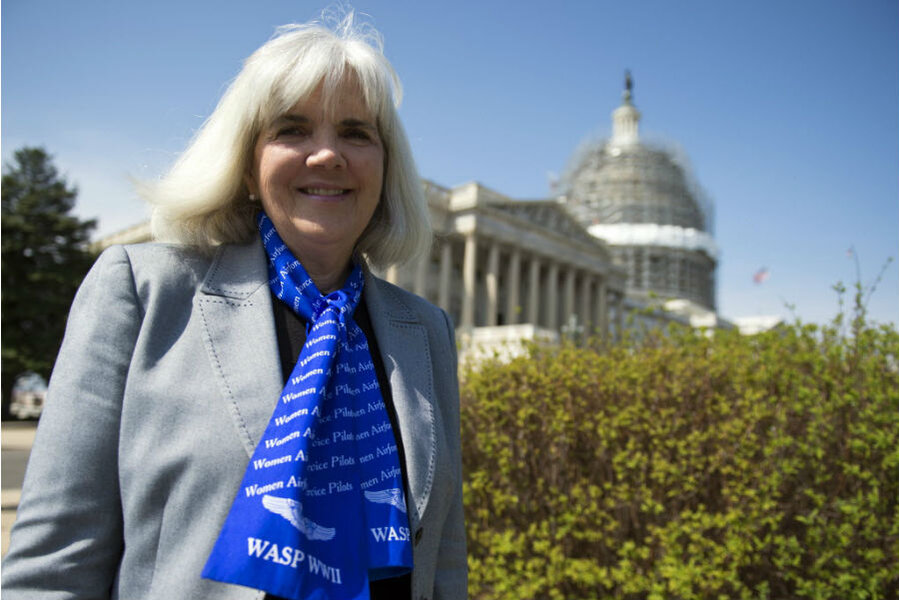Stinging victory: WASP finally wins her Arlington burial
Loading...
During World War II, Elaine Danforth Harmon was a member of the Women Airforce Service Pilots, or WASPs, a group of female civilian pilots working for the US Army. While WASPs were not allowed on combat missions, its members performed essential tasks in the continental United States that greatly contributed to the war effort.
Many of the women who flew these missions were laid to rest in Arlington National Cemetery over the years. But when Ms. Harmon passed away last year, her family was surprised to find that a rule had been passed prohibiting WASPs from being interred there.
It took a year of fighting and multiple petitions to get the restriction lifted by an act of Congress in May. At long last, Harmon's ashes will be interred at Arlington with full military honors on Wednesday.
During WWII, no US women were allowed to participate directly in combat, though many found themselves in combat situations throughout the duration of the war. The WASPs themselves were a paramilitary organization of civilian aviators who were employed and trained by the US Army Air Forces to fly on various missions within North America, freeing up their male counterparts for combat roles in Europe and the Pacific.
While the women were only permitted to fly missions in the continental US and Canada, 38 WASPs were killed during the course of the war as the result of various accidents, malfunctions, and other hazards. But since the women were technically civilians, the US Army that employed them would not allow the US flag to be put on the coffin of fallen pilots.
"It still bothers me," Jane Tedeschi, a former WASP aviator, told CNN in 2009. The government neglected to provide financial benefits and gave no military honors to WASPs who flew during the war and did not recognize their contributions for decades.
Things did get better for the women after many former WASPS successfully fought to be recognized as a military organization. Congress recognized the group as such in 1977, opening up veteran benefits for the living members of the group. WASPs won the right to an Arlington burial in a de facto Army ruling in 2002, as The Christian Science Monitor previously reported. In 2009, the surviving WASPs were honored with the Congressional Gold Medal.
Sarah Byrn Rickman, a WASP historian and an acquaintance of Harmon, told the Monitor in a telephone interview on Wednesday that as she attended the military funerals of some of her fellow pilots, Harmon became inspired by the recognition that the US government had finally given the group after so many years.
"I remember from what her daughter and her granddaughters have told me, she [Harmon] was so patriotically stirred by the fact that these women that she had served with were being honored at Arlington, were having their ashes or remains laid there, that she decided she wanted to be buried at Arlington, and left a written request for her daughter," says Ms. Rickman.
But in 2015, the 2002 ruling that allowed for the interment of former WASPs in Arlington National Cemetery was overturned with no fanfare and little warning by then-Secretary of the Army John McHugh. A post from Jan. 5 of that year on the cemetery's website explained that move was due to an increasing lack of space in the cemetery, as the Monitor reported in May.
“While certainly worthy of recognition, [the WASP service] does not, in itself, reach the level of active duty service required” said the site, claiming the eligibility criteria were “more stringent, due to space limitations.”
When Harmon's family found out about the change, they were shocked.
"Everyone was horrified," says Rickman. "Most of us WASP followers knew that Elaine had wanted to be buried there."
The family began circulating a petition on change.org – which ultimately gathered more than 170,000 signatures – and making visits to Capitol Hill. With the help of WASP historians like Rickman and several Congressional allies, they fulfilled Harmon's wishes.
One important supporter was Rep. Martha McSally (R) of Arizona, the first American woman to fly in combat in 1991. Representative McSally told the Monitor that she had always looked up to WASPs.
“There are certain times when it can be frustrating to break through those barriers – proving we have the capability to be fighter pilots – and the handful of times when I was tired of it or frustrated or discouraged, they [the WASPs] would inspire me to fight another day," she said.
The legislation to let WASPs be interred at Arlington was passed by a unanimous Senate vote and signed into law by President Obama in May, allowing Harmon's ashes to be interred at the cemetery with full honors.
"It sounds funny, but we're all kind of excited," Harmon's granddaughter, Erin Miller, told the Associated Press as the family prepared for the ceremony. "In a way, we've already grieved, and this now is about closure."
Rickman says that the funeral at Arlington is a victory for Harmon's family, for the 98 remaining WASPs, and for the country.
"This says something about how strongly the women of America, and, thank God, an awful lot of the men, understand what these women did in the war," says Rickman. "After 70 years, people have realized that they earned the same recognition as the men, because this was a group effort."
"And they did it, by God, they did it."








